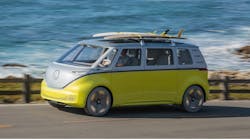Designed to recall the original Type 2 Microbus without mimicking it, a new version employs VW’s I.D. Buzz concept. The V in the bodywork calls back to the two-tone predecessor on the original Bus, but in the I.D. Buzz carries a light strip that surrounds the vehicle and gives it a unique visual signature. The LED headlights have hexagonal segments that act as “eyes” to communicate the vehicle’s status. With near-zero body overhangs and 22-inch wheels, the I.D. Buzz manages to look modern and timeless (Figure 1).
The I.D. Buzz is the second EV concept that VW has revealed for production, along with the original I.D. concept slated to enter production around 2019 as a 2020 model, while the I.D. Crozz concept has shown how an electric VW SUV could look. All three use VW’s Modular Electric Drive kit (or MEB, for its German acronym), a group of components and chassis parts engineered to maximize the potential of electric drive and future technology.
Within the framework of further development, Volkswagen has also set a launch date for the I.D. BUZZ. The vehicle will arrive at dealerships in 2022, after the compact four-door I.D. makes its debut. With the I.D. BUZZ, Volkswagen is mainly targeting markets in North America, Europe and China.
The first VW Bus had all of 30 hp (Figure 2). The I.D. Buzz concept sports 369 hp from electric motors on each axle that also provide all-wheel drive and the 111 kWh battery pack in the floor of the MEB chassis provide nearly 300 miles of estimated range. Using a VW fast-charge system, it can recharge about 80 percent of its energy capacity in 30 minutes at 150 kW. While speed was never a calling card of the original Bus, the Buzz offers ample performance of 0 to 60 mph in 5 seconds.
Just like the original Microbus, the design and engineering of the I.D. Buzz concept and MEB platform provides ample space for passengers or cargo. It can seat eight people with ease, and hold up to 162.5 cubic feet of cargo when the seats are folded or removed – the space of a full-size SUV on the footprint of a typical mid-size SUV. There’s even a front trunk, just like the original VW Beetle.
The I.D. Buzz concept also offers a preview of the type of autonomous technology that VW will develop for future models – namely its fully automated “I.D. Pilot” mode that could go into production by 2025. From the fold-away steering wheel and pop-up laser scanners in the roof to a heads-up display that integrates augmented reality, the I.D. Buzz does not lack for innovation.
Use of electric power creates many new ways to design a vehicle. With no need for a fossil-fuel engine, the overhang of the body in front of the wheels can be greatly reduced. With ample seating for eight, it can be reconfigured for dozens of uses, including sleeping. Most importantly for the design, much like the air-cooled Bus, the front end can be smooth for maximum aerodynamics; there’s even a small luggage compartment behind the front hood, much like the original Beetle.
The Buzz and the original I.D. also showcase Volkswagen’s plans for the future of self-driving vehicles. By staying constantly connected, the I.D. cars will know their drivers’ preferences and calendars and adjust accordingly. In manual mode, the driver would have a large heads-up display providing an augmented reality view of the roads ahead. In a fully autonomous state, the passengers in a Buzz could swivel their seats to face each other; the car would change the ambient lighting and pop out its steering wheel when needed.
Volkswagen has publicly committed to building three new electric vehicles off the MEB platform. One will be a compact like the original I.D. concept; another will be an SUV.
MEB Details
The Modular Electrification Toolkit (MEB) is a flexible modular system (actually a matrix of common parts) for manufacturing electric vehicles that’s currently being developed by Volkswagen (Figure 3). The MEB is being specifically developed to make the manufacture of electric vehicles more efficient — and potentially less expensive — in the long term. The MEB will allow Volkswagen to produce electric vehicles with a more systematic focus and to cater to increasing demand for electric vehicles. This platform allows either rear-wheel-drive with a single electric motor or all-wheel-drive with two motors, one up front and one in back.
Future generations of vehicles based on the MEB could bring advantages such as full torque from a standstill, rear drive and the advantages it brings to traction and acceleration, optimized driving balance (thanks to the lower position of the battery), and better digital functions.
A central element of the MEB is the high-voltage drive battery. Its design and placement plays a key role, as its flat and comprised of submodules. Components installed in the vehicle floor would free up an unexpected amount of space in the interior. For example, the outside length of the concept I.D. is similar to that of the VW Golf. However, it could offer a similar amount of interior space as a VW Passat. And the dashboard insert is more compact and the position of the center console can be varied.
Ever-changing technology, efficiency, and costs will determine new designs. Future elements like digitalization, connectivity, and fully automatic driving will also need to be factored into the MEB. What does a vehicle’s architecture need to look like to allow the integration of as many applications and interfaces as possible? Retrofitting hardware in a defined architecture is always a challenge, so digital locking systems for car sharing or sensors for autopilot should be implemented in the MEB right from the start.



